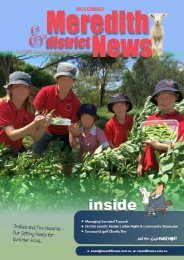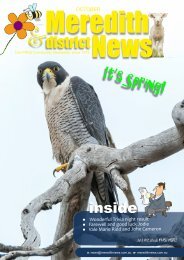Meredith News Feb 2021
Create successful ePaper yourself
Turn your PDF publications into a flip-book with our unique Google optimized e-Paper software.
16 MEREDITH and DISTRICT NEWS
In our Nature
Wendy Cook
Tiny irregular specks of brown, each a millimetre in
length, fall from a tree. Each is a seed, and each has the
potential to germinate and grow into a huge gum tree,
which could live for hundreds of years. Inside each
brown speck is a baby plant, waiting to grow. After the
gum tree’s flowers were pollinated by beetles,
fertilisation occurred and seeds began to develop. Inside
each seed, a tube connected the embryo to the parent
plant. Each embryo developed the beginnings of a root,
a shoot and its first leaves, the cotyledons. It was
surrounded by a supply of food and protected by a hard
seed coat. The cotyledons continued to grow until they
filled most of the seed. Around the seeds, the base of
the former flower hardened, became woody, and grew
into a gumnut with valves to release the seeds. The
seeds dried out and became dormant. The valves
remained closed. The tree waited.
On a recent stormy night, a small branch broke. It
remained stuck high in the tree. Now that the gumnut’s
connection with the tree’s food supply is broken, the
valves have opened, releasing the seeds. As they fall, a
gentle breeze catches them, and blows them down the
valley, where they sprinkle on the ground, ready to
germinate when conditions are right. When there has
been sufficient rain to provide a young plant with
moisture, the dehydrated seeds will take up water,
expand and burst through the seed coat. The cotyledons
hold a store of food which will move to the root. The
root will begin to grow, to hold the small plant in place
and find food and water. Next, the shoot will elongate.
The first true leaves will appear. Once all the food has
been drawn from them, the cotyledons will shrivel and
fall off. The young gum tree will have begun its life.
Gum trees are not the only plants that use wind to
disperse their seeds. Daisies, which include dandelions
and thistles, have soft hairs attached to the tops of their
seeds, like miniature parachutes, so that they can catch
the wind and fly long distances. The seeds are not fully
developed when they begin their flight. It will be a few
months before they are mature enough to germinate.
Banksias also spread their seeds on the wind, but wait
until a fire has passed. The woody cones keep the seeds
safe from flames. After the fire, the valves of the cones
open, each allowing two seeds to escape. Each seed has
a thin black wing which allows it to fly with the wind,
and hopefully land in a place where vegetation has been
burnt and there is an open space and a bed of nutritious
ash to feed the young plant.
released explosively, spreading a short distance away
from their parent, so they will not be competing with it
for food and water.
A common method for plants to spread their seeds is to
make use of animals. When the pods of wattles and
some peas mature, they crack open along their edges
and release the seeds, which fall to the ground. Each
seed is covered in a hard black seed coat, and has
attached to it an aril, a nutritious lump which attracts
ants. The aril is a good source of food, so the ants take
the seeds back to their nest. They remove the arils and
discard the seeds into a rubbish chamber. Here the
seeds remain safe from other animals, perhaps for
years. Eventually there will be enough moisture in the
soil to crack the seed coat, or the heat of a bushfire
passing above can crack it. Then a small wattle tree or
pea bush will grow out of the ground beside the ants’
nest.
Another way in which seeds can be spread by animals
is to be surrounded by a tasty fruit. Some of our local
indigenous plants produce small fruits, which attract
lizards, possums, wallabies and birds. Fruits soften and
change colour when the seeds are mature. Flax lilies
have small bright blue berries held up on stalks above
their long narrow pointed leaves. Mistletoe fruits are
eaten and spread by mistletoebirds. Nodding saltbush,
which is a tiny creeper, and small bushes of ruby
saltbush having inconspicuous flowers, but brightly
coloured fruits. After fruits are eaten, the animal may
travel quite a distance, before the seeds in the fruit pass
through its gut and are deposited on the ground.
There is a less pleasant way in which animals spread
seeds. Bidgee-widgees grow round burrs, in which each
of the numerous seeds has a few barbed spines pointing
outwards. These catch on the fur of any passing animal,
which later stops to pull them off. Grass seeds also
catch in fur. The seeds of spear grasses are particularly
sharp. They have a long twisted tail called an awn.
When a seed lands on the ground, it waits for rain.
Then the awn will slowly unwind, behaving like a
corkscrew, and drilling the seed into the ground and
planting it. Look out for them next time you are pulling
seeds out of your pet’s fur or your socks, and think
about where you discard the seeds. You are also
dispersing seeds for a plant.
Wendy
Water provides another easy way to move seeds, which
is very helpful to aquatic plants and those that grow
beside creeks and lakes. Some plants spread their seeds
unaided. One example is the little native geranium with
pale pink flowers. When their seeds are ripe, they are
















